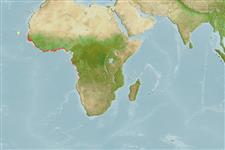>
Eupercaria/misc (Various families in series Eupercaria) >
Gerreidae (Mojarras)
Etymology: Gerres: Latin, gerres = a kind of anchovies; cited by Plinius.
More on author: Günther.
Environment: milieu / climate zone / depth range / distribution range
Écologie
marin; saumâtre benthopélagique; profondeur ? - 60 m (Ref. 57394). Tropical; 18°N - 17°S, 29°W - 14°E
Eastern Atlantic: west African coast, from Guinea to Congo (Ref. 57394). Also reported from Senegal (Ref. 4323, 28587, 33587), Gambia (Ref. 5476), Guinea-Bissau (Ref. 26999) and as far south as Angola (Ref. 3166).
Length at first maturity / Taille / Poids / Âge
Maturity: Lm 38.8, range 7 - ? cm
Max length : 20.0 cm TL mâle / non sexé; (Ref. 57394); common length : 15.0 cm TL mâle / non sexé; (Ref. 2683)
Épines dorsales (Total): 9; Rayons mous dorsaux (Total): 10; Épines anales 3; Rayons mous anaux: 8. Diagnosis: body oblong and compressed; snout pointed, shorter than eye diameter; mouth strongly protrusible; nostrils contiguous, situated at midpoint between eye and snout tip; dorsal fin deeply notched; pectoral fins long, reaching to, or extending beyond anal-fin origin; large cycloid scales; scales of the interocular space not reaching anterior border of eyes; spinous part of dorsal fin greyish, without a black spot at tip (Ref. 57394).
Coloration: back olivaceous-brown, sides silvery, with longitudinal dark bands; young individuals with narrow, dark vertical bars on sides; spinous part of dorsal fin distally greyish, but without a distinct black spot at tip; juveniles with 2 longitudinal series of dark spots on dorsal fin (Ref. 57394).
Occurs on littoral mud and sand bottoms to about 60 m depth (Ref. 57394). Often enters estuaries and coastal lagoons (Ref. 7375) during reproduction (Ref. 57394). Feeds on fish, shrimps, mollusks, plankton and detritus (Ref. 28587).
Life cycle and mating behavior
Maturité | Reproduction | Frai | Œufs | Fécondité | Larves
Roux, C., 1986. Gerridae. p. 325-326. In J. Daget, J.-P. Gosse and D.F.E. Thys van den Audenaerde (eds.) Check-list of the freshwater fishes of Africa (CLOFFA). ISNB, Brussels; MRAC, Tervuren; and ORSTOM, Paris. Vol. 2. (Ref. 4323)
Statut dans la liste rouge de l'IUCN (Ref. 130435)
Menace pour l'homme
Harmless
Utilisations par l'homme
Pêcheries: commercial
Plus d'informations
RéférencesAquacultureProfil d'aquacultureSouchesGénétiqueElectrophoresesHéritabilitéPathologiesTraitementNutrientsMass conversion
CollaborateursImagesStamps, Coins Misc.SonsCiguateraVitesseType de nageSurface branchialeOtolithesCerveauxVision
Outils
Articles particuliers
Télécharger en XML
Sources Internet
Estimates based on models
Preferred temperature (Ref.
123201): 23 - 28, mean 26.5 °C (based on 78 cells).
Phylogenetic diversity index (Ref.
82804): PD
50 = 0.5000 [Uniqueness, from 0.5 = low to 2.0 = high].
Bayesian length-weight: a=0.01047 (0.00564 - 0.01943), b=3.07 (2.91 - 3.23), in cm total length, based on LWR estimates for this species & Genus-body shape (Ref.
93245).
Niveau trophique (Ref.
69278): 3.2 ±0.51 se; based on food items.
Résilience (Ref.
120179): Haut, temps minimum de doublement de population inférieur à 15 mois (Preliminary K or Fecundity.).
Fishing Vulnerability (Ref.
59153): Low vulnerability (10 of 100).
Climate Vulnerability (Ref.
125649): High vulnerability (64 of 100).
Nutrients (Ref.
124155): Calcium = 172 [85, 323] mg/100g; Iron = 1 [1, 2] mg/100g; Protein = 18 [16, 20] %; Omega3 = 0.267 [0.132, 0.505] g/100g; Selenium = 50.4 [27.3, 98.0] μg/100g; VitaminA = 30.3 [9.0, 78.5] μg/100g; Zinc = 1.9 [1.3, 2.7] mg/100g (wet weight);
